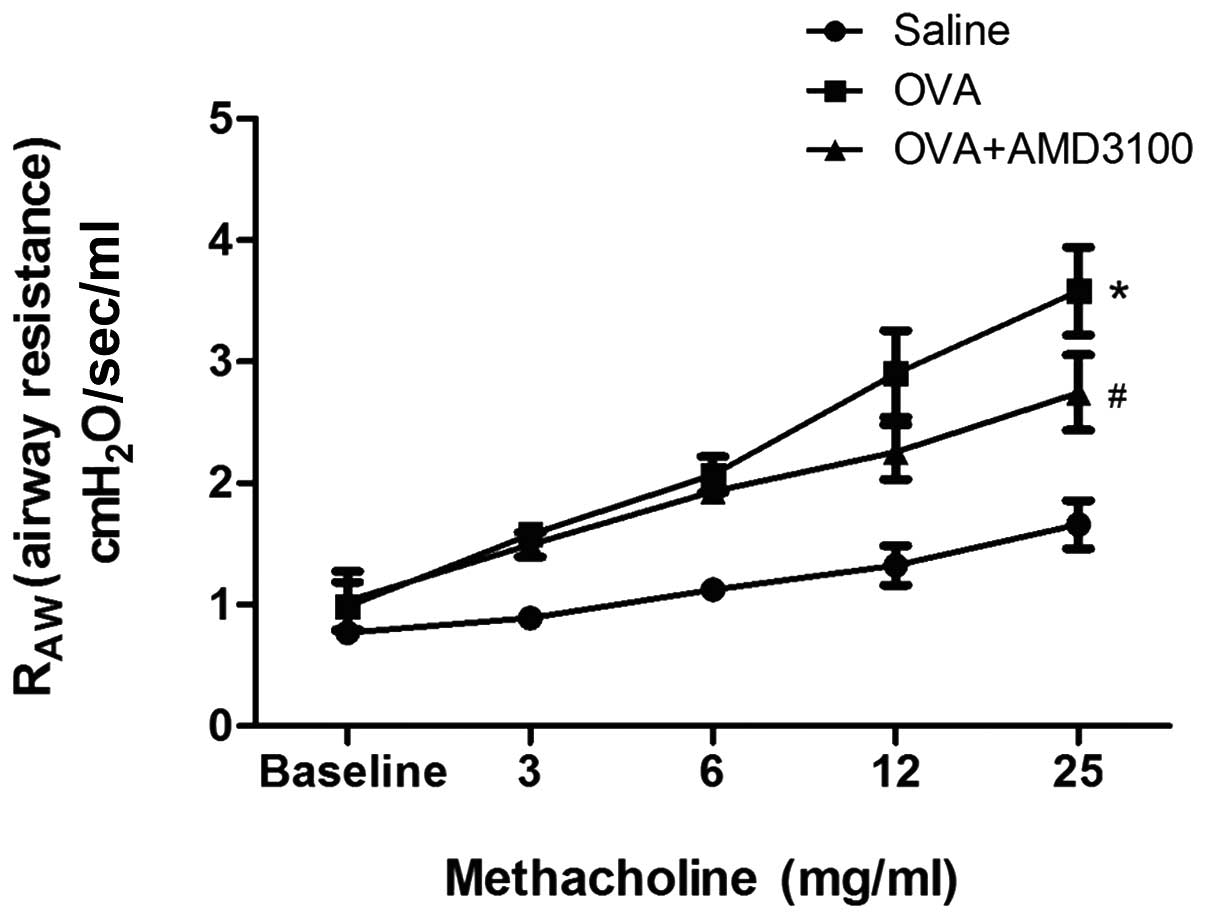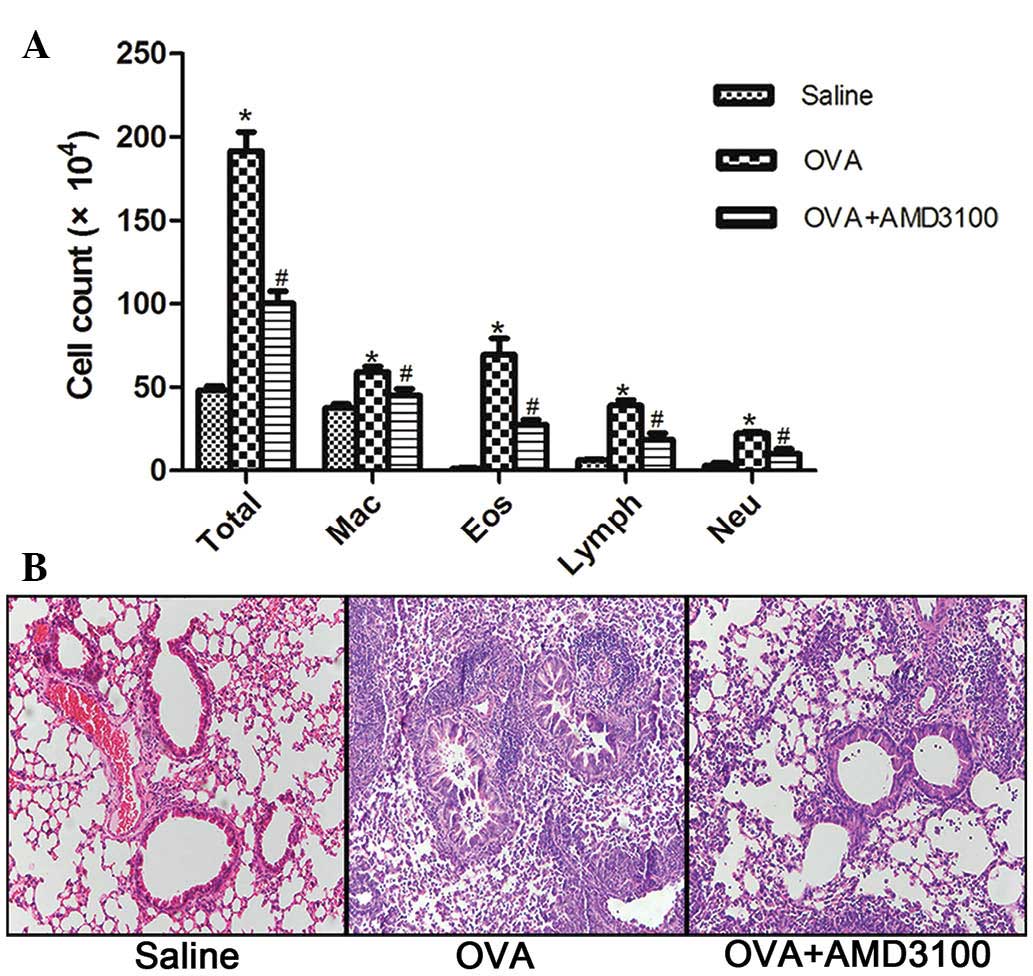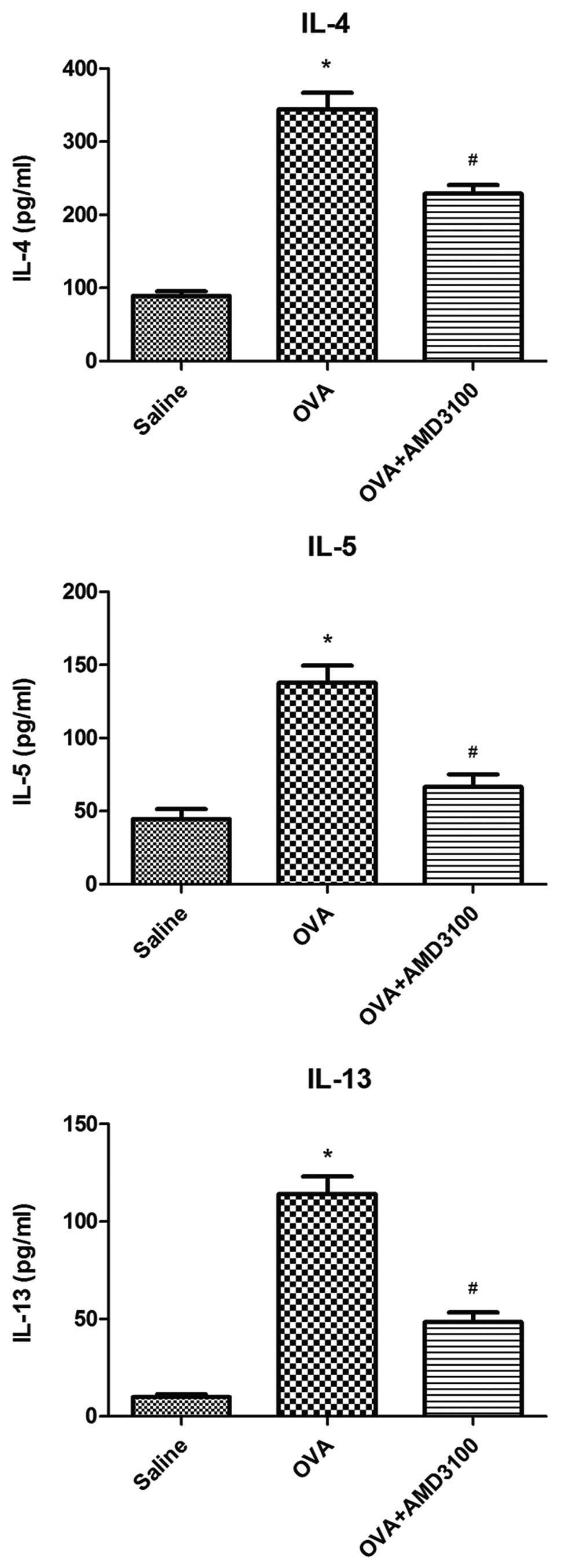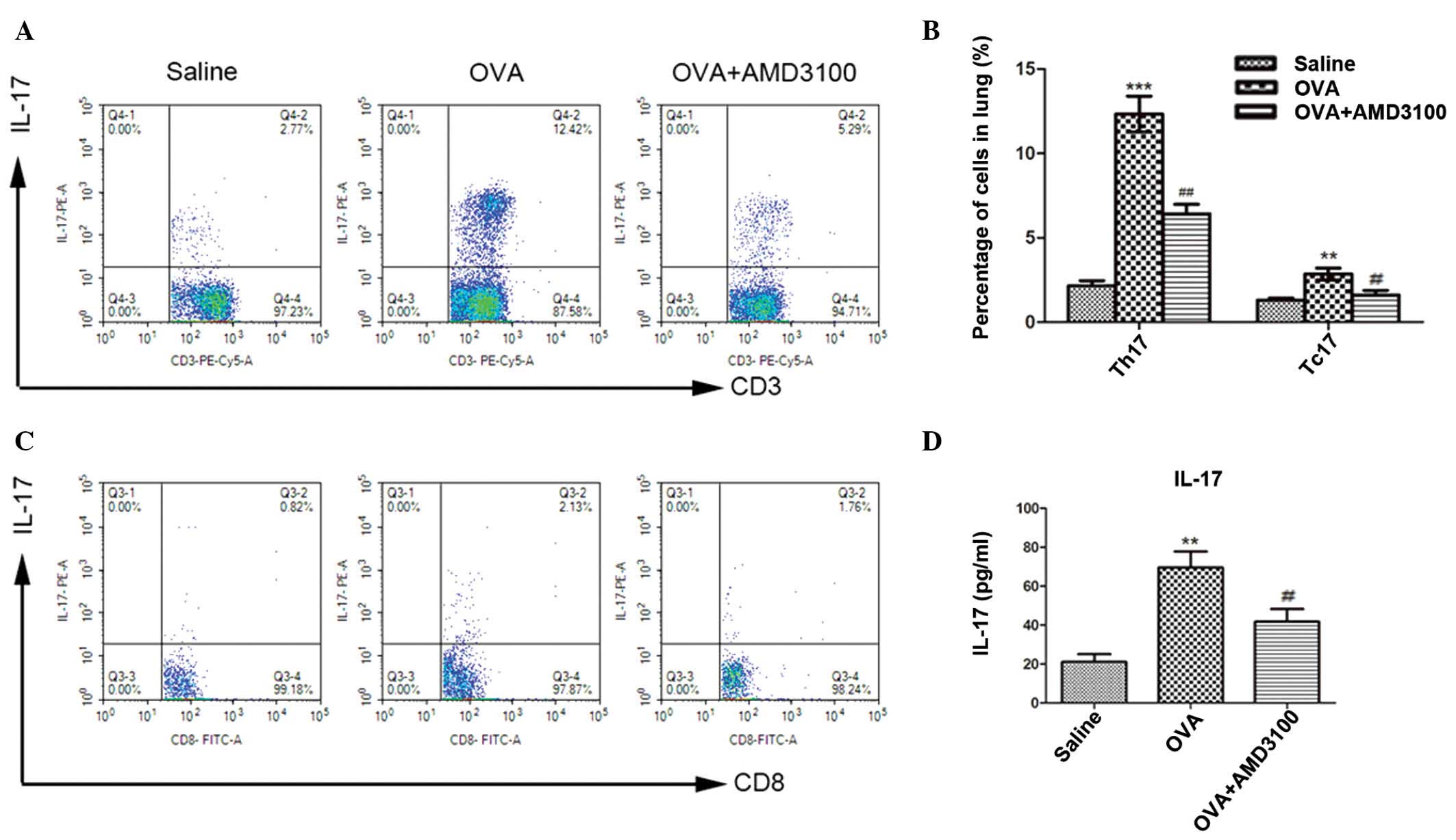|
1
|
Wills-Karp M, Nathan A, Page K and Karp
CL: New insights into innate immune mechanisms underlying
allergenicity. Mucosal Immunol. 3:104–110. 2010. View Article : Google Scholar : PubMed/NCBI
|
|
2
|
Shirozu M, Nakano T, Inazawa J, Tashiro K,
Tada H, Shinohara T and Honjo T: Structure and chromosomal
localization of the human stromal cell-derived factor 1 (SDF1)
gene. Genomics. 28:495–500. 1995. View Article : Google Scholar : PubMed/NCBI
|
|
3
|
McQuibban GA, Butler GS, Gong JH, Bendall
L, Power C, Clark-Lewis I and Overall CM: Matrix metalloproteinase
activity inactivates the CXC chemokine stromal cell-derived
factor-1. J Biol Chem. 276:43503–43508. 2001. View Article : Google Scholar : PubMed/NCBI
|
|
4
|
Daubeuf F, Hachet-Haas M, Gizzi P,
Gasparik V, Bonnet D, Utard V, Hibert M, Frossard N and Galzi JL:
An antedrug of the CXCL12 neutraligand blocks experimental allergic
asthma without systemic effect in mice. J Biol Chem.
288:11865–11876. 2013. View Article : Google Scholar : PubMed/NCBI
|
|
5
|
Lukacs NW, Berlin A, Schols D, Skerlj RT
and Bridger GJ: AMD3100, a CxCR4 antagonist, attenuates allergic
lung inflammation and airway hyperreactivity. Am J Pathol.
160:1353–1360. 2002. View Article : Google Scholar : PubMed/NCBI
|
|
6
|
Gonzalo JA, Lloyd CM, Peled A, Delaney T,
Coyle AJ and Gutierrez-Ramos JC: Critical involvement of the
chemotactic axis CXCR4/stromal cell-derived factor-1 alpha in the
inflammatory component of allergic airway disease. J Immunol.
165:499–508. 2000. View Article : Google Scholar : PubMed/NCBI
|
|
7
|
Negrete-Garcia MC, Velazquez JR,
Popoca-Coyotl A, Montes-Vizuet AR, Juárez-Carvajal E and Teran LM:
Chemokine (C-X-C motif) ligand 12/stromal cell-derived factor-1 is
associated with leukocyte recruitment in asthma. Chest.
138:100–106. 2010. View Article : Google Scholar : PubMed/NCBI
|
|
8
|
Molet S, Hamid Q, Davoine F, Nutku E, Taha
R, Pagé N, Olivenstein R, Elias J and Chakir J: IL-17 is increased
in asthmatic airways and induces human bronchial fibroblasts to
produce cytokines. J Allergy Clin Immunol. 108:430–438. 2001.
View Article : Google Scholar : PubMed/NCBI
|
|
9
|
Chakir J, Shannon J, Molet S, Fukakusa M,
Elias J, Laviolette M, Boulet LP and Hamid Q: Airway
remodeling-associated mediators in moderate to severe asthma:
Effect of steroids on TGF-beta, IL-11, IL-17 and type I and type
III collagen expression. J Allergy Clin Immunol. 111:1293–1298.
2003. View Article : Google Scholar : PubMed/NCBI
|
|
10
|
Nakae S, Komiyama Y, Nambu A, Sudo K,
Iwase M, Homma I, Sekikawa K, Asano M and Iwakura Y:
Antigen-specific T cell sensitization is impaired in
IL-17-deficient mice, causing suppression of allergic cellular and
humoral responses. Immunity. 17:375–387. 2002. View Article : Google Scholar : PubMed/NCBI
|
|
11
|
Barczyk A, Pierzchala W and Sozanska E:
Interleukin-17 in sputum correlates with airway hyperresponsiveness
to methacholine. Respir Med. 97:726–733. 2003. View Article : Google Scholar : PubMed/NCBI
|
|
12
|
Schnyder-Candrian S, Togbe D, Couillin I,
Mercier I, Brombacher F, Quesniaux V, Fossiez F, Ryffel B and
Schnyder B: Interleukin-17 is a negative regulator of established
allergic asthma. J Exp Med. 203:2715–2725. 2006. View Article : Google Scholar : PubMed/NCBI
|
|
13
|
Wakashin H, Hirose K, Maezawa Y, Kagami S,
Suto A, Watanabe N, Saito Y, Hatano M, Tokuhisa T, Iwakura Y, et
al: IL-23 and Th17 cells enhance Th2-cell-mediated eosinophilic
airway inflammation in mice. Am J Respir Crit Care Med.
178:1023–1032. 2008. View Article : Google Scholar : PubMed/NCBI
|
|
14
|
Weaver CT, Harrington LE, Mangan PR,
Gavrieli M and Murphy KM: Th17: An effector CD4 T cell lineage with
regulatory T cell ties. Immunity. 24:677–688. 2006. View Article : Google Scholar : PubMed/NCBI
|
|
15
|
Langrish CL, Chen Y, Blumenschein WM,
Mattson J, Basham B, Sedgwick JD, McClanahan T, Kastelein RA and
Cua DJ: IL-23 drives a pathogenic T cell population that induces
autoimmune inflammation. J Exp Med. 201:233–240. 2005. View Article : Google Scholar : PubMed/NCBI
|
|
16
|
Aggarwal S, Ghilardi N, Xie MH, de Sauvage
FJ and Gurney AL: Interleukin-23 promotes a distinct CD4 T cell
activation state characterized by the production of interleukin-17.
J Biol Chem. 278:1910–1914. 2003. View Article : Google Scholar : PubMed/NCBI
|
|
17
|
Huber M, Heink S, Grothe H, Guralnik A,
Reinhard K, Elflein K, Hünig T, Mittrücker HW, Brüstle A, Kamradt T
and Lohoff M: A Th17-like developmental process leads to CD8(+)
Tc17 cells with reduced cytotoxic activity. Eur J Immunol.
39:1716–1725. 2009. View Article : Google Scholar : PubMed/NCBI
|
|
18
|
Li K, Wang Z, Cao Y, Bunjhoo H, Zhu J,
Chen Y, Xiong S, Xu Y and Xiong W: The study of the ratio and
distribution of Th17 cells and Tc17 cells in asthmatic patients and
the mouse model. Asian Pac J Allergy Immunol. 31:125–131. 2013.
View Article : Google Scholar : PubMed/NCBI
|
|
19
|
Gong S, Li J, Ma L, Li K, Zhang L, Wang G,
Liu Y, Ji X, Liu X, Chen P, et al: Blockade of dopamine D1-like
receptor signalling protects mice against OVA-induced acute asthma
by inhibiting B-cell activating transcription factor signalling and
Th17 function. FEBS J. 280:6262–6273. 2013. View Article : Google Scholar : PubMed/NCBI
|
|
20
|
Kramer EL, Mushaben EM, Pastura PA,
Acciani TH, Deutsch GH, Khurana Hershey GK, Korfhagen TR, Hardie
WD, Whitsett JA and Le Cras TD: Early growth response-1 suppresses
epidermal growth factor receptor-mediated airway
hyperresponsiveness and lung remodeling in mice. Am J Respir Cell
Mol Biol. 41:415–425. 2009. View Article : Google Scholar : PubMed/NCBI
|
|
21
|
You QH, Zhang D, Niu CC, Zhu ZM, Wang N,
Yue Y and Sun GY: Expression of IL-17A and IL-17F in
lipopolysaccharide-induced acute lung injury and the counteraction
of anisodamine or methylprednisolone. Cytokine. 66:78–86. 2014.
View Article : Google Scholar : PubMed/NCBI
|
|
22
|
Sauer KA, Scholtes P, Karwot R and Finotto
S: Isolation of CD4+ T cells from murine lungs: A method to analyze
ongoing immune responses in the lung. Nat Protoc. 1:2870–2875.
2006. View Article : Google Scholar : PubMed/NCBI
|
|
23
|
Daubeuf F, Hachet-Haas M, Gizzi P,
Gasparik V, Bonnet D, Utard V, Hibert M, Frossard N and Galzi JL:
An antedrug of the CXCL12 neutraligand blocks experimental allergic
asthma without systemic effect in mice. J Biol Chem.
288:11865–11876. 2013. View Article : Google Scholar : PubMed/NCBI
|
|
24
|
Heesen M, Berman MA, Höpken UE, Gerard NP
and Dorf ME: Alternate splicing of mouse fusin/CXC chemokine
receptor-4: Stromal cell-derived factor-1alpha is a ligand for both
CXC chemokine receptor-4 isoforms. J Immunol. 158:3561–3564.
1997.PubMed/NCBI
|
|
25
|
Weaver CT: Th17: The ascent of a new
effector T-cell subset. Preface. Eur J Immunol. 39:634–636. 2009.
View Article : Google Scholar : PubMed/NCBI
|
|
26
|
Yen HR, Harris TJ, Wada S, Grosso JF,
Getnet D, Goldberg MV, Liang KL, Bruno TC, Pyle KJ, Chan SL, et al:
Tc17 CD8 T cells: Functional plasticity and subset diversity. J
Immunol. 183:7161–7168. 2009. View Article : Google Scholar : PubMed/NCBI
|
|
27
|
Yamashita N and Clement LT: Phenotypic
characterization of the post-thymic differentiation of human
alloantigen-specific CD8+ cytotoxic T lymphocytes. J Immunol.
143:1518–1523. 1989.PubMed/NCBI
|
|
28
|
Zhao Y, Yang J and Gao YD: Altered
expressions of helper T cell (Th)1, Th2, and Th17 cytokines in
CD8(+) and γδ T cells in patients with allergic asthma. J Asthma.
48:429–436. 2011. View Article : Google Scholar : PubMed/NCBI
|
|
29
|
Oboki K, Ohno T, Saito H and Nakae S: Th17
and allergy. Allergol Int. 57:121–134. 2008. View Article : Google Scholar : PubMed/NCBI
|
|
30
|
Zhao Y, Balato A, Fishelevich R, Chapoval
A, Mann DL and Gaspari AA: Th17/Tc17 infiltration and associated
cytokine gene expression in elicitation phase of allergic contact
dermatitis. Br J Dermatol. 161:1301–1306. 2009. View Article : Google Scholar : PubMed/NCBI
|


















